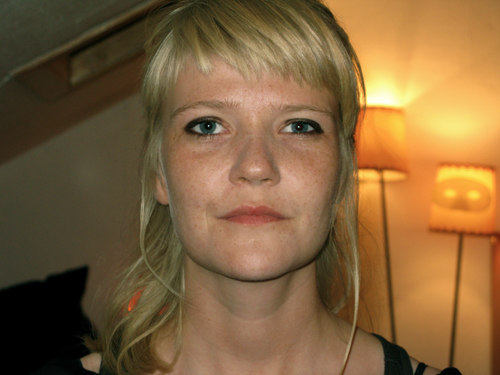Kristín Eiríksdóttir
“I don't know how I could be an artist without being brutal,” says poet and writer Kristín Eiríksdóttir, who will release a short story-collection in October. “Where would I find inspiration for that?”
 In 2004, murmured accounts of a compelling, vividly hallucinatory little book began spreading through Icelandic literary circles – an impressive debut by a young writer named Kristín Eiríksdóttir. Titled Kjötbærinn (lit. Meatville), and straddling the divide between poetry and narrative with deceptive ease, it was an enigmatic story of a pale shut-in of a girl, who lived with an avid heavy-metal aficionado named Kalvin on the top floor of an apartment building, with “a horrible ghoul who transmits evil to us via electronic equipment” for a neighbor.
In 2004, murmured accounts of a compelling, vividly hallucinatory little book began spreading through Icelandic literary circles – an impressive debut by a young writer named Kristín Eiríksdóttir. Titled Kjötbærinn (lit. Meatville), and straddling the divide between poetry and narrative with deceptive ease, it was an enigmatic story of a pale shut-in of a girl, who lived with an avid heavy-metal aficionado named Kalvin on the top floor of an apartment building, with “a horrible ghoul who transmits evil to us via electronic equipment” for a neighbor.
Critics were impressed by the work, which, despite its moody atmosphere, was characterized by a ideosyncratic sense of humor. “A powerful debut,” said the critic of Morgunblaðið, and Fréttablaðið employed similar imagery: “This unassuming book is rife with power.”
The next two books, similarly characterized by a rich atmosphere and a flair for the outrageously surreal, cemented her place among the country's most noteworthy writers. “A strong, concise work, a testament to the young poet's unequivocal talent,” was Morgunblaðið's opinion of Húðlit auðnin (Skin-Colored Wasteland), which appeared in 2006 and, like her debut, occupied the uncharted territory between poetry and short-story. Annarskonar sæla (A Different Sort of Bliss, 2008) followed in its wake, her first work that could be labelled, with absolute certainty, poetry. “I fell in love with this strange book,” was Fréttablaðið's reaction.
“There is a character named Doris. She dies.”
Sagenhaftes Island had a conversation with Eiríksdóttir, one day after she had turned in a manuscript for an all-new short-story collection – titled Doris deyr / Doris Dies and due to appear in October 2010. One of the stories in the work will be printed in the collection Best European Fiction 2011, published by Dalkey Archive Press.
“There is a character called Doris in one of the stories,” is Eiríksdóttir's explanation of the title. “She dies.”
That is about all she is willing to reveal about the content of the forthcoming work, but cautiously concedes that it will be her most traditional to date.
“This is pretty new to me. I wrote the stories in Canada, South America and Iceland, and they take place all across the world. There are ten stories, and while they're about different people, they're all connected in one way or another,” she says.
Gaps and silences, something unsaid
Eiríksdóttir, who is studying visual art in Montreal, admits that she occasionally envies film as a medium. “I'm wild about movies, and there are many directors who have influenced me. Sometimes I catch myself thinking: “Why am I writing? Images are what my generation understands. But then I realize that that the written word holds much more power. When you read, you need to fill in the gaps all the time, while a movie will just keep on pumping and pumping. The text will always be more personal inside your head. The gift of text is that you need to give something back.”
Indeed, Eiríksdóttir's prose is full of enigmatic gaps and silences – the persistent, nagging feeling of something left unsaid. “I've been playing around with that idea: trying to give an impression of something happening without actually giving anything definite away.”
Despite their inherent uncertainty, Eiríksdóttir's works are anything but visually vague. The outrageously surreal is counterbalanced with intensely physical, and often grotesque imagery: A character in Meatville, for instance, inexplicably gains the power of X-ray vision, and sees his girlfriend only as an assortment of entrails, bones and marrow.
I don't know how I could be an artist without being brutal,” Eiríksdóttir says. “Where would I find inspiration for that?”

